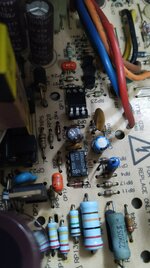I know this is an old thread but since I faced the "wobbly screen" thingy (after recapping everything) and busted my hoochie to find who the culprit was, I would like to share it with you.
The symptom was:
Power on -> wobbly screen, no beep.
At first I powered off right away.
Then powered on again.
Then off. Then on.
At SOME point, after a dozen of on/offs, it stabilized, gave me a beep and saw the arrow cursor.
At first I got happy.
But next day, when I first powered it on, it was again wobbling, no beep.
Like.... Capacitors had been discharged or something.
I repeated the above process and the result was the same.
After a dozen (or more) on/offs, it would stabilize and boot.
Next day, again the same.
At some point while trying to read the schematics, I said "#*(*#@( it, leave it on, while I'm searching the internet".
Lo and behold, after quite some time (I think it was 3 or 4 minutes of wobbling, maybe more), I heard a BEEP!
.... So, right now, the case is starting to build up and we have a few steady symptoms.
When the screen was steady (after the above efforts) I measured the 5 and 12v rails and they were 4,8 and 11,6.
I played a little with PP1 and could raise them. But the result was always the same.
On the next day, it would take again 3-4 or more minutes to "warm up" and stabilize.
I removed and measured all the diods. They were fine.
I started cussing again, so since I had read here about the optocoupler, I decided to change it (see attached image, I've put it on a stand...)
That did it.
When I turned it on, it was perfect!
So mind your optocouplers!
P.s. don't ask me why -prior to changing the optocoupler- after a while it would stabilize. I have absolutely no friggin idea.


